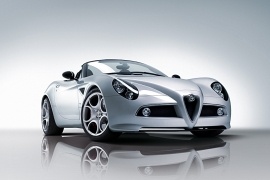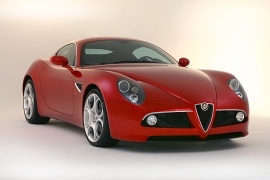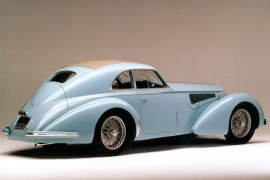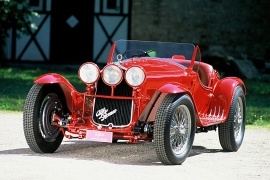ALFA ROMEO 8C Models/Series Timeline, Specifications & Photos
First production year: 1931
Engines: Gasoline
Body style: Coupé (two-door)
Alfa Romeo enchanted its fans in 2006 when it introduced the production version of the 8C Competizione and then again in 2008 at the Geneva Motor Show when it unveiled the open-top version of it, the 8C Spider.
The Italian automaker had a long and glorious motorsport history, including the 1931 8C, which won the famous 24 Hours of Le Mans four times back-to-back between 1931 and 1934. Those were not the only reasons why the Italian automaker revived the glorious but forgotten nameplate. It considered that it was the right moment to boost the image of the brand’s name in a market that started to focus more on mundane vehicles. Which Alfa Romeo never was. The Italian car manufacturer relied on a platform developed by Maserati and an engine supplied by Ferrari. Unfortunately, the world financial crisis hit the 500 units targeted sales, and as a result, the 8C Spider was produced in merely 329 units.
At the front, any hard-core Alfa Romeo enthusiast could see the resemblance between the 8C Spider and the 33 Stradale designed by Franco Scaglione in the ‘60s. Its three-headlamp layout of each headlight, covered by a clear lens that sported a triangular shape, was the same as in the 8C Competizione. Between them, the automaker fit the classic tri-lobo grille where the vertical triangle was flanked by broad scoops that hosted the fog lamps. On the lower side of the apron, the automaker added a lip spoiler.
The 8C Spider’s profile revealed the flowing, organic shapes of the bodywork. On the front fenders, the automaker placed an extracting vent behind the wheel arches. Above it, the design team created a sloped-down line that crossed the doors toward the rear quarter panels. The car’s waistline had risen above the rear fenders, resembling the coke-bottle styling of the muscle car era of the ‘60s. With its top down, the car revealed the safety arches neatly concealed behind the headrests. Behind the cabin, the car’s short deck sported a small duck tail. Finally, at the back, a pair of round taillights adorned the rear fascia, while below the bumper, on the sides, two pairs of exhausts peaked through the diffuser.
Inside the cabin, Alfa Romeo installed a set of carbon-fiber seats made by Sparco and covered in leather supplied by the Italian furniture manufacturer Poltrona Frau. The driver fronted a two-hump instrument cluster filled with two large dials for the speedometer and tachometer that flanked a monochrome (red and white) LCD that showed additional data from the car’s onboard computer. On the center stack, the automaker installed aluminum trims, the controls for the HVAC, and the sound system. A set of buttons that controlled the transaxle automatic gearbox were housed on the center console.
However, the most significant part of the vehicle was found under the hood, where Alfa Romeo installed the Ferrari-supplied F136 engine. The 90-degree V8 naturally aspirated powerplant delivered 80% of its maximum torque at around 2,000 rpm. That helped the open-top roadster rocket from zero to 100 kph (0-62 mph) in less than five seconds on its way to a top speed of 290 kph (180 mph).
The right car at the right moment was not the case for the Alfa Romeo 8C Competizione, which was introduced at the 2006 Paris Motor Show.
When the car was launched, the car-maker received over 1400 orders for it but, in 2007, when the dark clouds of the world economy crisis gathered, that list was shrunk, and since Alfa Romeo said that it will build only 500 of it. And that what it did.
Its long hood, triangular headlights with three headlamps inside, the Alfa Romeo shield in the middle of the grille extended with a bulge over the hood were some of the distinctive design cues of the car. The cabin was pushed further back and there was virtually no rear deck. For the taillights, the Alfa Romeo designers chose the round types, like the older Alfa Romeo sports cars.
Inside, the 8C Competizione featured two sport-bucket seats taken from Ferrari. They were built from carbon-fiber and covered with leather. The high center console hosted the buttons for the gearbox functions and driving modes, parking-brake switch, and the start-button. The instrument cluster featured two big dials and an LCD between them. In the back, there was a shelf for luggage. The trunk was almost non-existent.
The 8C was powered by a modified engine taken from the Maserati. It was mated to a 7-speed, dual-clutch gearbox mounted in the back. The limited-slip differential was standard as well. The top speed was slightly slower than the one of a Ferrari. Just because when you are Alfa Romeo, you don't want to irritate your bigger brother.
Alfa Romeo introduced the 8C 2900 B Berlinetta in two wheelbase versions, Corto (short) and Lungo (long). It was one of the best cars made by the Italian carmaker before WWII.
When the carmaker introduced the car to the market, it was the fastest production vehicle in the world. Its secret lay underneath the stunning bodywork: it was gifted with race car underpinnings.
The 2900B featured a bodywork designed and built by Carozzeria Touring Superleggera. The panels featured various cuts in non-essential areas to make the car lighter. At the front, the 8C 2900B featured a tilted radiator grille flanked by two headlights placed between the oversized, curved fenders and the engine compartment. Two slim bumpers protected the vehicle and were mounted in an advanced position than the grille. In addition, the design team created a tilted windshield and a narrow, arched greenhouse, while at the back, the sloped rear end revealed the trunk lid where the spare wheel was placed.
The interior featured a large-sized three-spoke steering wheel and a glovebox in front of the driver, while the two large dials for the speedometer and tachometer were in the middle. Since it was a special vehicle, Alfa Romeo fitted it with a leather interior. In addition, its sliding side windows allowed the passengers to get some fresh air.
Under the car's long hood stood a racing heart. The 2.9-liter supercharged engine provided more than 180 hp (182 PS) sent to the rear wheels via a four-speed transaxle gearbox. Its independent suspension in all corners made this car nimble on the corners, while the four drum brakes ensured a shorter stopping distance than most of its German competitors. After all, its chassis was carried over from the 8C 35 Grand Prix race car.
Alfa Romeo was already a race-winner in 1931 when it introduced the 8C Roadster as a sports-car for the public, and the new car promised to be a trophy-winner, and it was.
Alfa Romeo built just 188 cars for the market while the rest were race-cars. In those times, the differences between a race car and its showroom cousin were minimal. Tazio Nuvolari won the 1931 Italian Grand Prix at Monza race-track and the 1931-1932 Targa Florio road-race.
The 8C featured a unique front fascia for those times, sporting a three-headlamps at the front, in front of the radiator's grille. That's why the carmaker had to move the "Alfa Romeo" lettering on the lower side. There was no bumper for the race version. Yet, the street model featured a slim, easy to remove one. The two-seat cabin was just in front of the rear axle. To make the car more aerodynamic, the carmaker installed an aerodynamic shield on top of the spare-wheel. Last but not least, it featured an aluminum bodywork over a steel chassis.
Inside, the carmaker placed large dials from left to right of the dash-panel. In front of the co-driver, Alfa Romeo installed a clock and the fuel gauge. These were important, especially during a road race. In those times, the Italian carmakers installed the driving posts on the right side of the car, even if they were driving on the road's right side. Inside the cabin, the carmaker installed a solid, metallic handle (sort of an Oh-My-God bar) on the passenger's side.
Under the hood, Alfa Romeo installed an inline-eight engine with dual overhead camshafts and two valves per cylinder. A roots-type supercharger fed it through a Memini double-barrel carburetor.



